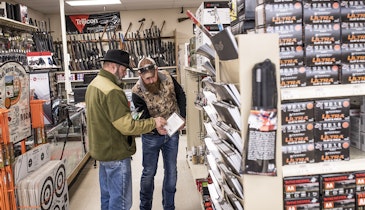By now you’ve probably heard about a U.S. Army-led effort to find a replacement for the M249 Squad Automatic Weapon, a 5.56mm, belt-fed machine gun in service for more than three decades.
This program is called Next Generation Squad Automatic Rifle (NGSAR), which the Army requires to address a capability gap. Our squads are being outgunned by the enemy, who field weapons with longer ranges.
The Army has this to say about NSGAR: “It will combine the firepower and range of a machine gun with the precision and ergonomics of a rifle, yielding capability improvements in accuracy, range and lethality. The weapon will be lightweight and fire lightweight ammunition, improving Soldier mobility, survivability and firing accuracy. Soldiers will employ the NGSAR against close and extended range targets in all terrains and conditions.”
NGSAR is a very ambitious program that requires the development of a weapon, ammunition and fire control system. The requirements for each of these components haven’t even been completely defined yet, and the military is relying on new procurement authorities to work with industry to examine various technologies to satisfy their need. Consequently, the earliest that the Army will field NGSAR is 2022.
Over the past few years, Defense officials have shared their frustration over how slow it is to procure new capabilities. Congress responded by granting DoD with “Other Transactional Authorities.” A component of these new types of procurement is called a Prototype Opportunity Notice that offers industry a means to develop and demonstrate desired capabilities with compensation as well as government test and evaluation.
Small businesses are paid for their work, while large companies must fund their own development. Either way, participating manufacturers receive testing paid for by the government as well as analysis of their effort. Conversely, the government gets access to various technologies that may or may not satisfy their needs, allowing them to refine requirements for actual procurement.
A demonstrator is a system consisting of a functional prototype weapon, 2,000 rounds ammunition(s), fire control (day and night), bipod, suppressor, enablers (optional), spare part(s) to support firing 2,000 rounds, special tools and operator manuals capable of firing and demonstrating the proposed capabilities to meet the lethality requirements.
There’s been a lot of bad information published on the program. For instance, NGSAR will not fire caseless ammunition. That failed technology was demonstrated by a team led by German manufacturer Heckler & Koch in a late 1980s program called Advanced Combat Rifle. However, at least one company developing a prototype is utilizing an ammunition type called case-telescoping that requires a completely new action to load, fire and eject from the weapon. But the ammo requirement is quite straightforward. They don’t care how a company gets there; the ammunition must be “20 percent less than an equal brass case weight volume of the entire cartridge.”
Much of the information provided to industry remains classified, as they don’t want to disclose to our enemies what we are working on to achieve small arms overmatch. For instance, while the Army did not specify an ammunition, preferring to see what industry could come up with, it did specify a chamber pressure that is much higher than any other small arm on the market and offered a government surrogate projectile in 6.8mm.
The weapon should be 35 inches overall length including a suppressor that must offer 140 dB performance. NSGAR will feature Safe, Semi-Automatic and Automatic modes, with 400m dispersion. Although the desired rate of fire is 60 rpm, that is going to be a challenge with a box-fed weapon.
Fire control is the final, critical component of this program. Its inclusion alone kept many firearms manufacturers from participating due to the costs and unique technical expertise required to produce these components. Likewise, electronics manufacturers lacked the know-how to produce firearms, meaning companies had to form teams with one another.
In July, the Army announced it had chosen five companies to produce six different prototypes: AAI Corporation Textron Systems, FN America LLC, General Dynamics-OTS Inc., PCP Tactical, LLC and Sig Sauer Inc. They will have one year to complete their work. FN America was selected to produce both box and belt-fed variants.
After this year is over, the Army plans to repeat the process, issuing refined parameters. As of now, there’s no requirement for participation in the first PON in order to be selected for the second. That year-long effort will be called the Future Follow-On System Integration Prototype Project.
After that, the Army will weigh the available technologies against their desired end-state, and may issue a Future Follow-On Production and Development Effort(s), awarding up to two independent follow-on 10-year contracts. The P&D effort may include low rate initial production, operational test and evaluation, full rate production, fielding and sustainment capability. The Army wants to buy more than 15,000 weapons with fire control and other enablers and 30,000,000 rounds of ammunition with planned transition to Government run production.
Ultimately, they want both a new squad and individual weapon. The Army decided that there would be more challenges in developing a squad weapon with its higher sustained rates of fire, so they began with it. Very shortly we should see the first requirements emerge for the individual weapon, a scaled down NSGAR. As you can see, there are multiple efforts that must be completed to select an actual replacement for the M249 SAW by 2022.






